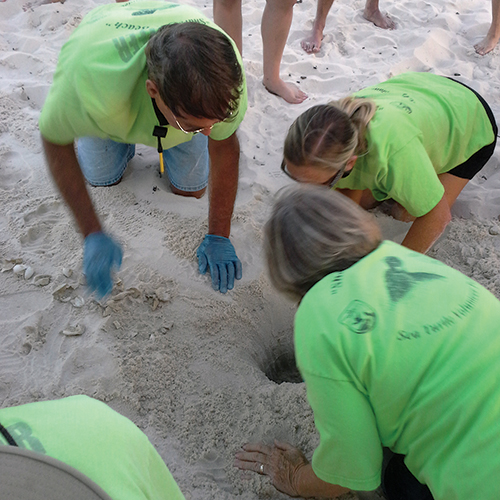Spring, summer are turtle time on Gulf Coast
By Thomas V. Ress
In the twilight on a deserted stretch of beach on Alabama’s Fort Morgan Peninsula, a lonely figure kneels and gently touches a stethoscope to the warm sand. Over the din of the crashing surf, Debi Gholson, a volunteer with the Share the Beach program, strains to hear a faint sound underground. She is listening to a loggerhead sea turtle nest, hoping to detect the telltale scratching of hatchlings breaking out of their shells and digging toward the surface.
“I hear movement!” Gholson says. We are thrilled that tonight we could witness the remarkable sight of dozens of baby turtles frantically erupting from the sand and madly sprinting to the protective waters of the Gulf of Mexico.
Loggerheads are one of Alabama’s rarest and most fascinating wild animals — giant marine turtles that usually weigh 150 to 400 pounds (although some have been reported up to 800 pounds) and measure as much as four feet across the shell. Loggerheads spend almost their entire lives in the ocean; the females touch land only to nest. On a warm summer night, a female will crawl onto a beach, dig a cavity with her hind flippers and deposit up to 150 pliable ping-pong ball-sized eggs. She then fills in the cavity and lumbers back into the ocean, never to see the nest again.
What happens after that is dependent on weather and a dozen other factors. If the sun sufficiently warms the eggs, hurricanes bypass the beach and coyotes and other predators miss the nest, after about two months the eggs hatch and dozens of baby turtles miraculously bubble out of the sand and dash across the beach, dodging hungry gulls and crabs, before reaching the relative safety of the ocean. This fragile scene is repeated hundreds of times every summer on southeastern beaches.

Many of these beaches are located in Alabama, and Fort Morgan Peninsula is a particularly important nesting area — in 2014, 80 nests were found on Alabama beaches and 42 of those were on the peninsula. Most of the nests were found by volunteers with Share the Beach, a nonprofit conservation group, which patrols the beaches during the May through August nesting season. Once they find a nest, they monitor it until it successfully hatches.
One of these nests is the one we are standing over tonight. Fifteen minutes after Gholson detected the first subterranean stirrings, the sand starts to quiver and a black pinky-finger sized head pops out. A tiny flipper appears, then another and finally a cookie-sized turtle squirts out and sprints toward the surf. Instantly, the sand comes alive with dozens of baby turtles emerging from the sand. This hatching flurry is called a “boil” and within minutes, more than 60 baby loggerheads magically pop into the moonlight.
What follows is both wondrous and comical as a handful of volunteers scurry around in the dark, shepherding dozens of confused and speedy critters toward the Gulf of Mexico. Evolution has conditioned the hatchlings to head toward light — which for eons was moonlight reflecting off the surf. But today artificial lighting from streetlights, condos and beach houses lures them inland, away from the surf. Volunteers repeatedly herd the babies toward the water and away from the dunes. Hordes of hungry ghost crabs lurk in the wings. If the volunteers weren’t here, there would be a deadly feast on this beach. After more than an hour, the last hatchling disappears into the dark surf. Sixty-nine eggs hatched, and all of the hatchlings made it safely to the water.
But the hatchlings face formidable challenges. Only a small percentage survive to maturity — some get entangled and drown in fishing nets; some choke to death on plastic bags, balloons, and other trash that they mistake for jellyfish, their favorite food; and beachfront development destroys the deserted beaches they need for nesting.
One of the potentially biggest threats was the 2010 BP oil spill. Although the long-term effects of the spill are still unknown, based solely on numbers of nests reported by the Share the Beach program, nesting has not been impacted. According to Mike Reynolds, director of Share the Beach, in 2010 the number of nests was low, but 2011 and 2012 set records before returning to the normal range in 2013 and 2014. But Reynolds says nesting numbers only tell the short-term impact and not the whole story.
“What if oil in the environment is affecting hatchlings in ways we don’t yet know?” he says. “What if the oil affects the hatchling’s ability to reproduce? What if they are sterile? Nest mortality and other data are still being studied and we may not know the true impacts for years.”
One thing we do know for sure is that the turtles imprint on their birth beach and one day the survivors will return to the same beach to lay the seed for yet another generation. The dedicated work of the volunteers and professionals who monitor and protect Alabama’s sea turtles give hope that we will witness the return of sea turtles to Alabama beaches for decades to come.
If you are interested in volunteering with Share the Beach, visit www.alabamaseaturtles.com.





